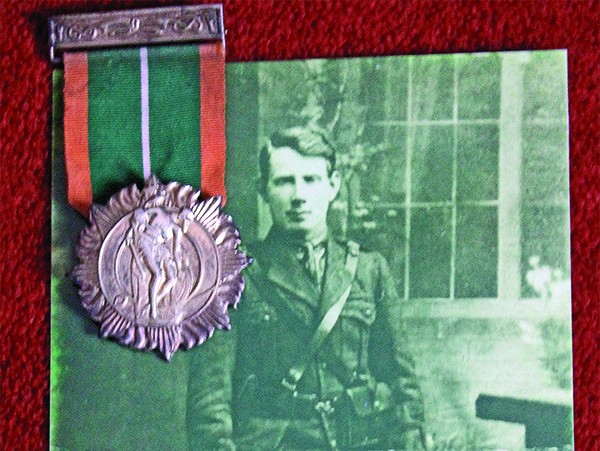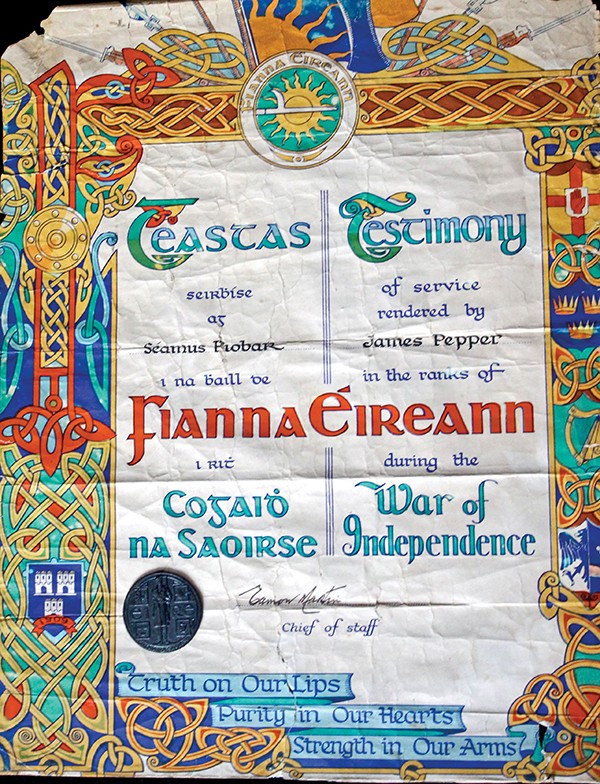
Above: Frances Bradshaw’s grandfather James Pepper during the rising with Medal.
Given the patriotic surge that has encapsulated the nation regarding the 1916 Easter Rising, it comes as no surprise that family ties to the aforementioned events will come into focus.
Irishtown local Frances Bradshaw is no exception to this, although she might well be considered a rare case on this topic given the fact that she had not one, but two grandfathers who took part in the Easter Rising.
Frances was kind enough to invite NewsFour to her home to discuss her family’s robust association to the moment that changed Ireland’s destiny forever and gave us a fascinating look at their service records and the medals they were honoured with.
Her grandfather James Pepper was formerly of George Reynolds House, Irishtown. He was a mere 15 years old when the Rising broke out. Due to his youthful appearance and diminutive stature, people took very little notice of him when he took on his role as a messenger and as a runner under Éamon de Valera in the battle of Boland’s Mill, as he relayed messages between the various garrisons.
James Pepper originally hailed from Mount Street, and lived on Seapoint Terrace, Irishtown after he had married his wife. He went on to become more heavily involved in the Irish Civil War and Frances says that, in the aftermath of an amnesty declared on the prohibition of firearms post-Civil War, he took the step of burying two of his own weapons in a lead box in the area where UCD now stands. Was this box containing two remarkable pieces of Irish history ever discovered? We simply do not know.
Daniel Canny was Frances’s grandfather and her mother’s father. Grandfather Canny was also present on the fateful day of the Croke Park massacre in 1920 and Frances recounted the moment when he saved the life of a young boy.
“I used to sit on his bed in his house on North George’s Street,” Frances told NewsFour. “And he would tell me how the British came in with their artillery and how he saved a young boy and that the only way he could save him was by jumping on him.”
Frances also provided us with Dan Canny’s biography from his Roll of Honour. Dan Canny was born in 1885 in Tulla, County Clare. He was employed as a barman in O’Meara’s Public House, 70 North Strand Road in 1916, and after the Rising he also owned two pubs on Capel Street.
He was a member of the Irish Republican Brotherhood and also of C. Company, 2nd Battalion, Dublin Brigade. On Easter Monday he joined the Volunteers and Irish Citizen Army men under the command of Tom Craven and Vincent Poole that occupied the Vitriol Works, located between Ballybough Bridge and Annesley Bridge.
Dan Canny arrived with his group at the GPO on Tuesday evening and he was assigned to the Metropole Hotel, subject to orders from Lieutenant Oscar Traynor. It was here that he was tasked with boring through the walls of adjacent buildings.
From Wednesday, his position became very precarious as the Hotel was then exposed to heavy artillery and sniper fire, while he spent his Thursday keeping rifles ready for marksman Harry Boland, while the roof was absolutely enveloped in flames. They were then forced to retreat to the GPO on Friday, and after that building’s subsequent evacuation, he helped in boring through the walls of the houses of Moore Street.
While under the command of Sean McLoughlin, he was part of the faction that was ready to charge the British Army barricades at Parnell Street, shortly before surrendering. Dan Canny was then among the first to be deported to Knutsford Prison in Cheshire, England and was then interned in Frongoch until July 26th 1916.
“It was actually my grandfather’s duty to blow up Nelson’s Pillar!” Frances told NewsFour. “But he was in charge of guarding the explosives. He bombed his way through to Jervis Street Hospital to bring the injured there.”
In 1917, Canny rejoined C. Company, 2nd Battalion and later transferred to D. Company, 2nd Battalion, Dublin Brigade. Like James Pepper, he also fought in the War of Independence and was indeed present in the crowd during the horrors of Bloody Sunday. He fought on the Republican side during the Civil War.
He was also something of a hurling fanatic and was even a founding member of the Young Irelands Hurling Club in 1923, where he upheld the position of club secretary for 26 years. He passed away on April 15th 1967 and was buried in Glasnevin Cemetery like so many other Irish heroes.
Dan Canny and his brother Joseph are also to be honoured in their native Clare with a commemorative plaque towards the end of April or beginning of May.

Above: The Certificate awarded for his services during the War of Independence.
By Craig Kinsella



